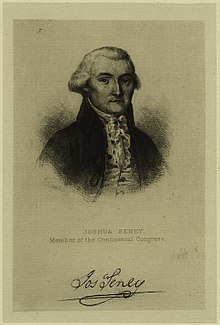Joshua Seney
Joshua Seney | |
|---|---|
 | |
| Member of the U.S. House of Representatives from Maryland's 2nd district | |
| In office 1789–1792 | |
| Preceded by | Inaugural holder |
| Succeeded by | William Hindman |
| Personal details | |
| Born | March 4, 1756 near Church Hill, Province of Maryland, British America |
| Died | October 20, 1798 (aged 42) near Church Hill, Maryland, U.S. |
| Political party | Anti-Administration Democratic-Republican |
| Spouse(s) | Frances Nicholson |
| Relations | William Few (brother-in-law) Albert Gallatin (brother-in-law) John Montgomery (brother-in-law) |
| Parent(s) | John Seney Ruth Benton Seney |
| Alma mater | College of Philadelphia |
Joshua Seney (March 4, 1756 – October 20, 1798) was an American farmer and lawyer from Queen Anne's County, Maryland. He represented the state of Maryland in the Continental Congress, and the second district of Maryland in the House of Representatives.
Early life[]
Joshua was born to John Seney (1730–1795) and Ruth (née Benton) Seney in 1756 on the family farm near Church Hill in the Province of Maryland. His grandfather, Solomon, was a French Huguenot refugee who arrived in Maryland around 1727. By the time Joshua was born the family were prosperous farmers and planters. He was educated in local schools and then attended the College of Philadelphia (now the University of Pennsylvania), graduating in 1773.[1][2]
Career[]
After Seney was admitted to the bar, he confined himself to a private practice. In 1779, he served as the High Sheriff of Queen Anne's County, Maryland.[1]
Continental Congress[]
During the early days of the Revolutionary War Seney busied himself with the care of the family's farms since his father was active as a Lt. Colonel in the militia. He was appointed the sheriff of Queen Anne's County in 1779. He was elected to the Maryland state House of Delegates, and served there from 1785 to 1787. In 1788, Seney was sent as a delegate to the Continental Congress.[1]
United States Congress[]
After returning to his farm, Seney was again called to political service when he was elected to the First United States Congress in 1789.[3] He was re-elected for the 1791–1793 term as an Anti-Administration candidate but resigned from Congress on December 6, 1792 to take up his new duties as a judge of the state court for the district of Baltimore. He served as Chief Justice of the Third Judicial District of Maryland from 1792 to 1796.[1]
In 1798, Seney ran for Congress again as a Republican. He defeated the incumbent Federalist, William Hindman but died before taking office.[1]
Personal life[]
Seney was married to Frances "Fanny" Nicholson (1771–1851) of the prominent Nicholson family of Maryland.[4] Fanny was the daughter of Commodore James Nicholson and was the sister of Catherine "Kitty" Nicholson (wife of William Few),[5] Hannah Nicholson (wife of Albert Gallatin),[6] James Witter Nicholson (husband of Ann Griffin, daughter of Isaac Griffin),[7] Maria Nicholson (wife of John Montgomery),[8][9] and Jehoiadden Nicholson (wife of James Chrystie).[10][11] Together, Joshua and Fanny were the parents of:[12]
- Joshua Seney Jr. (1793–1854), who married Ann Ebert (1803–1879), the parents of Judge Henry William Seney.[4]
Seney died at home on October 20, 1798 and was buried in a family plot on his farm near Church Hill in Queen Anne's County. His grave can now be found in the churchyard of St. Luke's Church.[1]
References[]
- ^ a b c d e f "SENEY, Joshua - Biographical Information". bioguide.congress.gov. Biographical Directory of the United States Congress. Retrieved April 1, 2019.
- ^ "Representative Joshua Seney". www2.gwu.edu. First Federal Congress Project. Retrieved April 1, 2019.
- ^ Society, United States Capitol Historical (2000). Neither Separate Nor Equal: Congress in the 1790s. Ohio University Press. p. 11. ISBN 9780821413272. Retrieved April 1, 2019.
- ^ a b Revolution, Daughters of the American (1921). Lineage Book. The Society of the Daughters of the American Revolution. p. 73. Retrieved April 1, 2019.
- ^ Johnson, Dale T. (1990). American Portrait Miniatures in the Manney Collection. Metropolitan Museum of Art. p. 183. ISBN 9780870995972. Retrieved April 1, 2019.
- ^ Dungan, Nicholas (2010). Gallatin: America's Swiss Founding Father. NYU Press. pp. 51–52. ISBN 9780814721117. Retrieved April 1, 2019.
- ^ "James Witter Nicholson letters, 1792-1834". www.columbia.edu. Columbia University. Retrieved April 1, 2019.
- ^ McKenney, Janice E. (2012). Women of the Constitution: Wives of the Signers. Scarecrow Press. pp. 59-60. ISBN 9780810884991. Retrieved April 1, 2019.
- ^ Brown, Charles Brockden (2013). Collected Writings of Charles Brockden Brown: Letters and early epistolary writings. Rowman & Littlefield. p. 598. ISBN 9781611484441. Retrieved April 1, 2019.
- ^ Roosevelt, Hall; McCoy, Samuel Duff (1939). Odyssey of an American family: an account of the Roosevelt and their kin as travelers, from 1613 to 1938. Harper & brothers. p. 216. Retrieved April 1, 2019.
- ^ Library, Columbia University Rare Book and Manuscript (1992). A guide to the manuscript collections in the Rare Book and Manuscript Library of Columbia University. G.K. Hall. pp. 180, 309. ISBN 9780816105168. Retrieved April 1, 2019.
- ^ Scribner, Harvey (1910). Memoirs of Lucas County and the City of Toledo: From the Earliest Historical Times Down to the Present, Including a Genealogical and Biographical Record of Representative Families. Western Historical Association. p. 246. Retrieved April 1, 2019.
External links[]
- United States Congress. "Joshua Seney (id: S000242)". Biographical Directory of the United States Congress.
- Joshua Seney at Find a Grave
- 1756 births
- 1798 deaths
- Continental Congressmen from Maryland
- Members of the Maryland House of Delegates
- Members of the United States House of Representatives from Maryland
- University of Pennsylvania alumni
- People from Queen Anne's County, Maryland
- Maryland Democratic-Republicans
- Farmers from Maryland
- Maryland sheriffs
- Democratic-Republican Party members of the United States House of Representatives
- 18th-century American politicians
- American lawyers admitted to the practice of law by reading law
- Elected officials who died without taking their seats